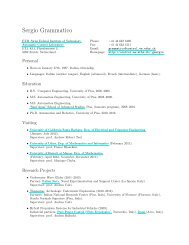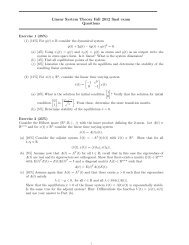Model Predictive Control
Model Predictive Control
Model Predictive Control
You also want an ePaper? Increase the reach of your titles
YUMPU automatically turns print PDFs into web optimized ePapers that Google loves.
3.5 Operations on P-collections 43<br />
the original ones, i.e. ( q i=1 Qi) = ( p i=1 Pi), (ii) q is minimal, i.e. there exists<br />
no set {Qi}i=1,...,q with a smaller number of polyhedra, (iii) the new polyhedra are<br />
mutually disjoint, i.e. Qi = Qj for all i, j ∈ {1, . . .,q}, i = j, and (iv) the new<br />
polyhedra are formed as unions of the old ones, i.e. for each Qj, j ∈ {1, . . .,q},<br />
there exists an index set I ⊆ {1, . . .,p}, such that Qj = <br />
i∈I Pi.<br />
This problem is equivalent to an optimal merging problem. Next, we remove Requirements<br />
(iii) and (iv) thus allowing for overlaps in the resulting polyhedra.<br />
Problem 3.2 (Non-Disjoint Optimal Complexity Reduction) Given an initial<br />
set of polyhedra {Pi}i=1,...,p satisfying Assumption 3.1, the non-disjoint optimal<br />
complexity reduction problem amounts to derive a new set of polyhedra {Qi}i=1,...,q<br />
with Properties (i) and (ii) as in Problem 3.1.<br />
Strictly speaking, the second problem is not a merging problem, but a more general<br />
optimal set covering problem, which is equivalent to logic minimization frequently<br />
used in digital circuit design. Nevertheless, we will sometimes use the term merging<br />
instead of complexity reduction.<br />
Next, the assumption that the original polyhedra are cells in a hyperplane<br />
arrangement and that markings are available are removed, but require additionally<br />
that each polyhedron is represented with a minimal number of facets. This problem<br />
can be considered as the general non-disjoint optimal complexity reduction problem<br />
for PWA functions.<br />
Problem 3.3 (General Non-Disjoint Optimal Complexity Reduction) Given<br />
an initial set of polyhedra {Pi}i=1,...,p where Assumption 3.1 is not required to hold,<br />
the general non-disjoint optimal complexity reduction problem amounts to derive<br />
a new set of polyhedra {Qi}i=1,...,q with Properties (i) and (ii) as in Problem 3.1,<br />
and (iii) the number of facets for each Qi being minimal.<br />
All three tasks are non-trivial, as the union of polyhedra is in general nonconvex,<br />
and because we are aiming at deriving the optimal solution, more specifically,<br />
the set of polyhedra with the minimal cardinality. Indeed, the problems<br />
are N P-hard (see [73] and references therein). As a direct consequence, fast algorithms<br />
are unlikely to exist leaving us either with rather long computation times<br />
or suboptimal solutions.<br />
Our interest in this problem will be clear later in this book (Section 10.2) when<br />
computing the PWA state-feedback control law to optimal control problems. Once<br />
the PWA state-feedback control law has been derived, the memory requirement and<br />
the on-line computation time are linear in the number of polyhedra of the feedback<br />
law when using standard brute force search. Therefore, we will be interested in the<br />
problem of finding a minimal representation of piecewise affine (PWA) systems,<br />
or more specifically, for a given PWA system, we solve the problem of deriving a<br />
PWA system, that is both equivalent to the former and minimal in the number of<br />
regions. This is done by associating with different feedback law a different color,<br />
and we collect the polyhedra with the same color. Then, for a given color, we<br />
try to merge the corresponding P-collection by solving one of the three problem<br />
described above. If the number of polyhedra with the same affine dynamic is large,



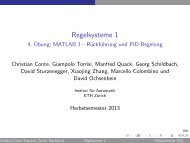
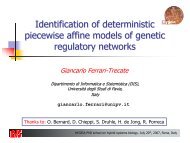
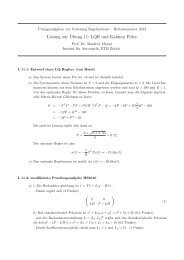

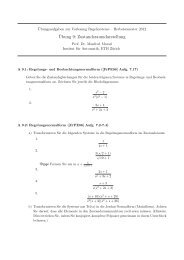
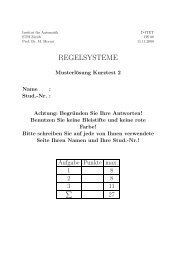

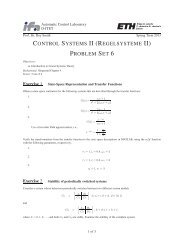
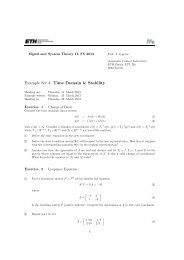

![Convex Optimization: [0.5ex] from Real-Time ... - ETH Zürich](https://img.yumpu.com/18678007/1/190x143/convex-optimization-05ex-from-real-time-eth-zurich.jpg?quality=85)
